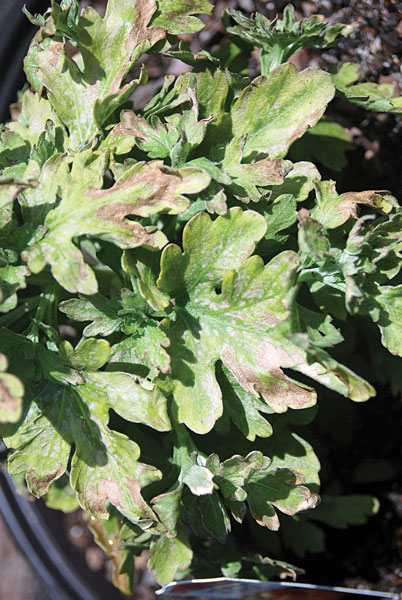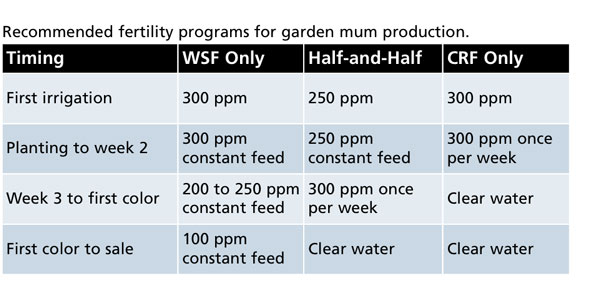7/1/2019
Feed Me, Seymour!
Virginia Brubaker

Fall garden mums are an important revenue source for many professional ornamental growers. While traditional production methods can yield a good crop, adopting a newer philosophy can help growers produce strong, uniform and well-branched plants with greater predictability.
Pictured: High soluble salts burn on a garden mum.
Fertilizer philosophy
The ideal soil pH for garden mums is 5.4 to 5.8. Depending on the alkalinity of the water source, acid-forming fertilizers or sulfuric acid injection may be helpful to keep soil pH in the desired range. Growers solely using controlled-release fertilizer (CRF) will need to rely on acid injection for high-alkalinity water sources. Your supplier can help direct you with these decisions.
Garden mum fertility can be achieved through CRF, water-soluble fertilizer (WSF) or a combination of the two, which we refer to as the half-and-half approach. For growers using overhead irrigation, a CRF program is often more efficient. Growers using drip irrigation tend to prefer WSF.
A half-and-half approach provides both flexibility to adjust the fertility program and protect against leaching from rains, as CRF provides a constant supply of fertility. Any use of CRF requires the use of WSF in the initial two weeks to meet the heavy nutritional needs of the crop and to encourage soft growth to support maximum branching.
Mum crops achieve optimum plant structure due to significant branching early in the crop. To encourage this free branching, growers should encourage soft growth in the first two to three weeks of production. This is best achieved via fertilizers that provide more phosphorus than we normally use for the rest of the crop cycle. Regardless of the fertility program selected, all mums should be irrigated with a 20-20-20 or 20-10-20 WSF during the first two to three weeks of production.
For the main part of the crop, growers using WSF-only or half-and-half programs should switch to a lower phosphorus formulation, such as a 20-10-20, and rotate with a fertilizer that contains calcium, such as a 15-0-15. The rate and frequency of application during this time should be reduced from the early rates.
A rotation of three to four applications of the acid fertilizer to one application of the calcium feed is recom-mended. This 3 to 4:1 rotation will provide adequate calcium for later stem strength while allowing proper management of the media pH. The rotation may need to be adjusted based on the alkalinity of the irrigation water. Regardless of the alkalinity, the important thing is to provide adequate calcium to the crop during this phase of production.
Pumping iron
Mums aren’t particularly efficient at taking up iron and are quick to show symptoms of iron deficiency. As media pH rises above the ideal range, the availability of iron decreases.
Iron deficiency symptoms begin with interveinal yellowing of the youngest foliage in the growing tips. Mum varieties vary somewhat in their threshold for showing iron deficiency, so it’s common to see the problem begin in just a few varieties, progressing through the field if corrective measures aren’t taken.
 Adjusting the soil pH down to the ideal range is the first step in preventing or correcting iron deficiency. If necessary, chelated iron can be applied to correct the issue. Sprint 138 or 330 can be applied as a drench at 4 to 5 oz. per 100 gallons. We don’t recommend foliar sprays or dry treatments to the soil because of the increased potential for phytotoxicity.
Adjusting the soil pH down to the ideal range is the first step in preventing or correcting iron deficiency. If necessary, chelated iron can be applied to correct the issue. Sprint 138 or 330 can be applied as a drench at 4 to 5 oz. per 100 gallons. We don’t recommend foliar sprays or dry treatments to the soil because of the increased potential for phytotoxicity.
Never apply chelated iron to plants under water stress. Always rinse the foliage with clear water following application of iron to avoid a pitting burn, which can occur if the solution is allowed to dry on the foliage.
More magnesium
Mums also benefit from additional magnesium. One of magnesium’s key roles is in the photosynthesis process of chlorophyll production, which makes leaves green. Magnesium is most easily provided with Epsom salts. For constant application, use 2 oz. of Epsom salts per 100 gallons, along with your non-calcium-based fertilizer. Alternatively, pulse treatments of 8 oz. per 100 gallons on a biweekly basis or as needed. Magnesium deficiency in mums appears as an interveinal chlorosis of the lower (older) leaves.
Mums are heavy feeders, but they’re still susceptible to damage from high soluble salts. The most common causes of high-salts damage are drought and applying fertilizer to overly dry media. Both situations result in the plant perceiving a very high salts gradient in the root zone, leading to damage on the foliage. Avoid drought stress and always ensure adequate soil moisture at the time of fertilizer application. GT
Virginia Brubaker is GGSPro Technical Support Supervisor for Griffin. She can be reached at ggsprotech@griffinmail.com.